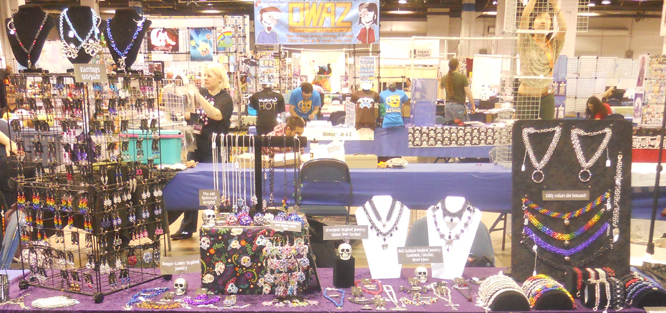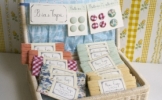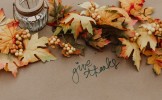It's a sinking feeling like none other. You're busy in your craft fair booth, answering customer questions and ringing up sales. Then you happen to glance down at your table when traffic dies down a bit.... and notice that one of your handmade creations is missing. You're sure you didn't sell it. Someone has stolen from you!
This happened to me for the first (and, so far, only) time about a year ago at a huge convention. At first, I was in denial, and frantically pulled up my tablecloths and searched the floor, looking for the missing bracelet. Once I realized that someone had indeed walked away with it without paying, I was furious at the thief, whoever he or she might have been. How dare someone steal from an independent artist? I halfheartedly toyed with the idea of putting up a big snarky sign reading "If you must shoplift, go to your favorite big box store instead; they can afford it!" But then, I turned that anger toward myself. How had I let this happen? Why hadn't I been more vigilant?
Unfortunately, theft happens in today's world, and shoplifters don't necessarily have respect for a handmade artist's livelihood. I just finished vending at that same convention this year, and this time I was determined to take better precautions. And I'm happy to report that nothing disappeared from my table this time! Here's what I did differently:
Have Helpers
Looking back, I know exactly when and why I was stolen from. I was resizing a necklace for a customer, and it was a trickier-than-usual task due to the piece's design. Normally, I can keep one eye on my booth while I'm resizing, but not this time. I was concentrating hard on the task at hand and didn't look up for a while — I made it easy for someone to steal. And, I was working alone.

How To Build an Artist Website
Sign up for our newsletter and get the book How to Build an Artist Website for free!
This is one reason why it's crucial to have booth helpers, if at all possible. If I'd had a friend working my booth with me, she could've kept an eye on the other shoppers while I was focused on that necklace.
Pay Attention to Every Shopper
Even though this convention is packed with thousands of people, I made a point this year of saying hello to every single person who stopped by my table. Not only does this help shoppers feel at home in your booth, it can also chase away shoplifters. People who are looking to steal don't want to be noticed or recognized, so it's likely they'll move on to the next booth.
Avoid Blind Spots in Your Display
Crafters are always told to create height in their booths — and tall, eye-catching displays definitely help draw people in from across a crowded room! Last year, I used fabric-covered boxes and crates to get my jewelry up at shoppers' eye level. They looked great. They were also so tall, I couldn't see over them when I stood behind my table. Guess where the stolen bracelet had been? Yep, lying flat on the table, right in front of my tallest tower and completely blocked from my view
This year, I used portable gridwall (shown at left in the photo below) for my tall displays. I could see right through it, and keep an eye on customers' hands as they touched and tried on my work. I also placed my hand mirror at an angle that let me clearly see the far end of my long table, when no one was using the mirror to try on jewelry. That was a total accident — I didn't realize it gave me a great view until I sat down behind my table — but it proved surprisingly effective!

See-through grids and jewelry secured to my displays helped me avoid theft at this year's convention.
Consider Securing Your Items
The stolen piece was loose on the table, waiting to be swept away. This year, I experimented with clips and pins that fastened jewelry to my displays. Customers could still touch and try on my work, but it took them a bit more effort and time, and usually two hands, to take a piece down. If your pieces require a little work to remove, it's likely that a would-be thief will pass your table by and seek out an easier mark.
The ultimate secure display is a locked glass case that lets customers look, but not touch unless they ask. I personally don't care for these, as my work sells best when folks can easily pick it up and feel its weight and texture. But, if I were selling really high-end precious metal or gemstone pieces, I'd probably revisit that stance.
Have you ever been stolen from at a show? If so, what steps did you take to prevent theft at future events?




